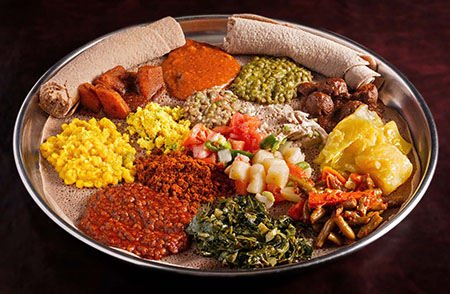The region around modern day Ethiopia was exposed to various exotic spices from India, chile peppers from Portugal, and ginger from East Asian countries as far back as the 1400s. Indigenous to Ethiopia, grains such as sorghum, millet, teff, and wheat grow well in the temperate climate and are used in many Ethiopian dishes. Ethiopian cuisine today is a blend of introduced spices and food items coupled with indigenous grains and proteins.
Ethiopian food marries together earthy, spicy, tart, sour, and pungent flavors. A base seasoning, used in a wide variety of savory and spiced Ethiopian dishes, is a blend of spices known as Berbere. Most Berbere seasoning is made with chile peppers, fenugreek, cinnamon, ginger, cardamom, and coriander.
Ethopian dishes are also often paired with a sour fermented teff flour bread called Injera. Injera is rolled into a large flatbread and the food is served on top of it. When eating a dish involving injera, no utensils are involved. Simply tear off a piece of injera, scoop up a bite size amount of food, and then enjoy the flavors.
Traditional Ethiopian dishes
Tibs is a delicious dish of beef cut into small chunks sauteed with onions, garlic, and berbere seasoning that is paired with injera.
Shiro be Kibbe is a red, saucy legume or lentil stew combining ground split pea, chickpeas, and a spiced butter.
Kitfo is an Ethiopian beef tartare: ground raw beef mixed with a spiced butter.

